In 2012, worldwide interest was aroused by the discovery of 1,280 pieces of art ranging from Monet to Picasso in the Munich apartment of Cornelius Gurlitt. Ronald Harwood followed this exciting and surprising story and completed his play Degenerate Art in 2014 after Gurlitt’s death. The play premiered in November 2015 at the Renaissance Theatre in Berlin.
The Renaissance Theatre is notable for its beautiful Art Deco interior and for its long record of successful productions in German of plays from England, America, and Paris. These have included Michael Frayn’s Democracy and Noises Off and Yasmina Reza’s Art. There is a corps of excellent actors who are joined by notable actors from other cities. Udo Samuel is an actor whose name is familiar to theatregoers throughout Europe. He has appeared in many plays at theatres including the Burgtheater in Vienna and the Schaubühne in Berlin, with roles reaching from Wozzeck to King Lear. He has repeatedly worked with directors such as Peter Stein and Luc Bondy. Clearly he is at the top of his profession and his performance of the role of Gurlitt indicates the artistic level of the small Berlin theatre.
The scenography of the play focused on visual art in a spectacular way. Designer Herbert Schaefer created a dramatic beginning with an open curtain and a stage totally draped in a huge black cover which was raised to reveal the backs of dozens of paintings. The intermission became a part of the play as the paintings were turned to face the audience and literally filled the stage. The play concluded with the projection of many of the most famous paintings on a screen upstage.
Degenerate Art has only four characters; each pursues and reveals the complex questions the actual case presented. Gurlitt’s possession of paintings stolen from Jews or removed by the Nazis from museums as “degenerate art” was morally indefensible, but the legal questions are not so clear. Of course a central question in the play is what sort of a man lived without employment, without acquaintances, surrounded by this amazing collection of art while maintaining his mother’s lie that all had been burnt in the bombing of Dresden. The play was a challenging and successful presentation that was enthusiastically received by a full house.
My Fair Lady
On the Berlin musical stage, the premiere of My Fair Lady at the Komische Oper sold out very quickly. This is a very popular and familiar musical in Germany, with the title always in English. Most Germans can hum or sing the songs. The scenery by Franz Philipp Schloessmann was simply a number of old-fashioned gramophones ranging in size from small to enormous plus one living room chair on wheels. These elements were used by all the major characters throughout the performance. The athletic cast climbed on them, slid down inside them and pushed them off and on the otherwise bare stage.
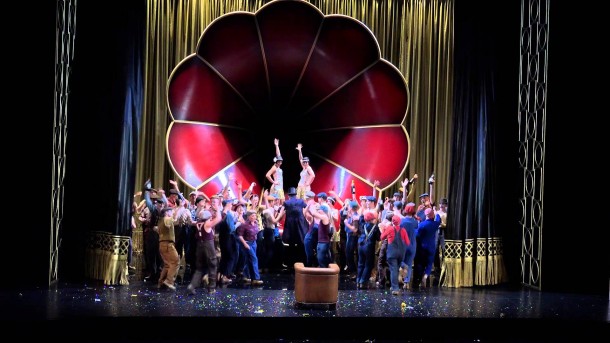
My Fair Lady by Frederick Loewe, directed by Kristiina Poska. Photo credit: Iko Freese.
Katharine Mehrling is a popular favorite with audiences at the Komische Oper. She danced, jumped, and belted out her songs with great vivacity. Max Hopp is a familiar Berlin actor, trained at the Ernst Busch Hochschule. He has performed in many German cities in roles ranging from Wozzeck to Prometheus. As Higgins, he was very engaging. The most affecting moments of the musical came at the end as he stood alone watching the gramophones disappearing into the wings as he sang “I’ve Grown Accustomed to Her Face” (Ich bin gewohnt on Ihr Gesicht). As he ended the song he stood on the great barren stage contemplating his apparently barren future. Director Andreas Homoki has created sensations with his frequently startling interpretations. (His production of Offenbach’s Die Schoene Helene had most of the cast on roller skates.) No doubt some people come to the Komische Oper today anticipating a sort of thumbing the nose at straightforward or conventional productions of older musicals. My Fair Lady fulfilled these expectations and will join the repertoire with Kiss Me Kate and West Side Story.
Aida
The advance excitement over the new staging of Aida at the Deutsche Oper arose from the totally rearranged configuration of orchestra, soloists, chorus, and audience. The arriving audience was directed to take seats earlier than usual because of possible confusion. Director Benedikt von Peter created the following set-up: the orchestra filled the usual stage; the orchestra pit was covered; and the soloists performed there minus the chorus members who were dispersed throughout the auditorium.
What the audience saw initially was essentially the same throughout the opera. Stage right was a large desk and behind it, on a large screen on the stage, were projected its papers, clippings, a calendar book, and other usual things. All over the new “stage” were television sets and high on either side were screens with projections of persons singing from their places in the audience. Standing by their seats in the audience were the eighty-six members of the chorus. In the course of the opera minor changes were shown on the onstage screen such as Amneris slicing bread and some very German wurst as she sang to Radames. Aida was on the acting level until the last scene when she appeared at the front of the balcony singing the duet with Radames who was on the stage level but projected onto the screen near her.
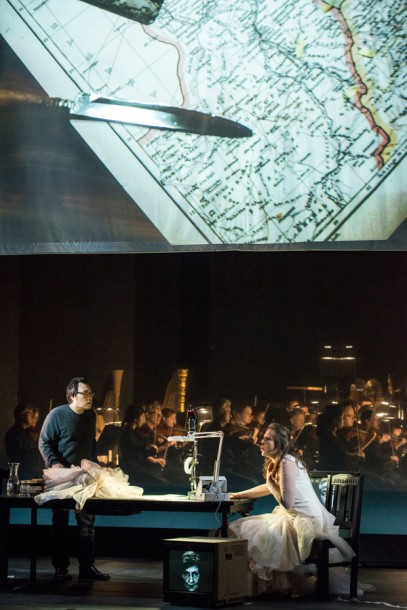
Aida by Giuseppe Verdi, directed by Benedikt von Peter. Photo credit: Marcus Lieberenz.
In interviews von Peter said that the arrangement threw out routine and confronted the audience with something new. He commented that placing the chorus near the spectators surprised them and communicated the physical power and presence of the singers. For the singers, the staging was also new and exciting because the soloists, too, in their places on the covered orchestra pit put them in proximity to the spectators and could feel their new excitement and interest in the singing. There is no doubt that the sound of the opera was a great experience for the spectators, literally filling the entire space. Some people were stunned by how loud the nearby singer could be. At the conclusion, the applause and cheers were rapturous. The scale of the event was clear in the curtain call with the huge orchestra nearly filling the stage and the sizeable chorus and soloists all together. This was a memorable premiere for the Deutsche Oper.
Staatsballett Berlin
The first premiere of the season for the Staatsballett Berlin was an offering of three pieces by noted prizewinning choreographers. The three exhibited similar elements which reflect contemporary ballet but were markedly different in themes, music, and costuming. The audience for the premiere would best be described as friendly: throughout the ballets there was applause and cheering. In one, as the dancers pulled up their shirts to reveal their bodies there was laughter and humorous comments were called out.
Nacho Duato is the Intendant of the company as well as the chief choreographer. In his ballet Castrati he intended to show “the dark side of a theatre convention.” The nine male dancers were seemingly nude for most of the ballet and eight of them brutalized the intended victim, hauling him about the stage, tossing him, and forming strange and often beautiful bodily configurations with him. At points several of the dancers appeared in long black capes with large red circles on the back creating a stark visual image. The music, a combination of Vivaldi and contemporary composer Karl Jenkins, contributed to the excitement of the production.
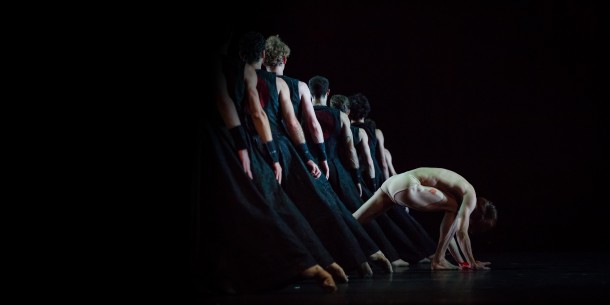
Castrati by Nacho Duato. Photo credit: Yan Revazov.
Juri Kylian has choreographed ballets for companies throughout the world but is chiefly associated with the Netherlands Dance Theatre where he serves as choreographer and co-director. There he has created sixty works, the most frequently performed of these being Petite Mort. The term and the theme of the ballet attempt “to describe the ecstasy of a sexual union.” Six men and six women, again seemingly naked, created fascinating movements demonstrating “a ritual of aggression, energy, and violation” as they played out the idea of a “small death.” The dynamic, startling dancing was in counterpoint to the slow piano concertos 21 and 22 by Mozart.
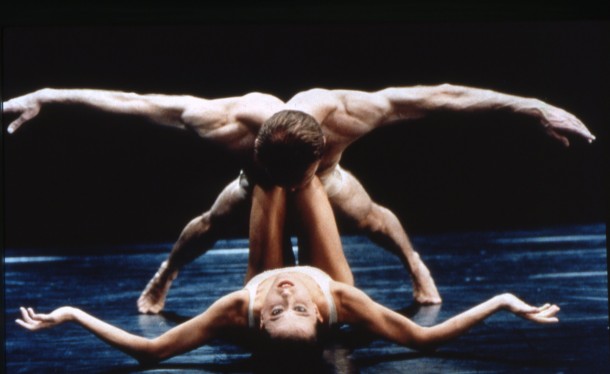
Petit Mort by Jiří Kylián. Photo Credit:.
Secus was choreographed by Israeli Ohad Naharin, artistic director of the Batsheva Dance Company. He is considered one of the major figures in contemporary dance. “Contemporary” clearly describes Secus in which a large group of male and female dancers leaped, rolled, and struck poses to music ranging from Chari-Chari’s “Favorite Final Geisha Show” to the Beach Boys’ “You’re Welcome.” At the first blast of music the dancers were revealed standing absolutely still for several minutes. One of the conceits of the performance was that each of the dancers walked formally onto the stage and after exuberant movements walked formally off the stage. Naharin describes his work as a method of teaching the dancers the power of the combination of vertical and horizontal dancing in combination. The contemporary music, the movement and even the costumes (which might have been tee shirts and pants worn to a rehearsal) appealed to the audience. During the intermission, people discussing the ballet used words such as “powerful” and “energetic.” Duato has successfully combined contemporary works such as these three with older ballets. Later in this season would be performances of Onegin (John Cranko choreography) and several classical ballets. There would also be new works by Duato and Killian.
The Triumph of Time and Disillusion
A pleasing and unusual production by the Staatsoper Unter den Linden was Handel’s oratorio The Triumph of Time and Disillusion. What should an eighteenth-century moral lesson have to say to a modern audience? Director Jürgen Flimm created a stunning production which has been very popular. Handel’s work has a very clear and simple subject: the salvation of Beauty, delivering her from Pleasure and her decadent past. The timelessness of the subject is reminiscent of the medieval play Everyman, but here the central figure is a woman who has a chance to redeem herself before Death comes for her.
The setting was a luxurious, elegant bar with decorative columns reaching upwards to a far removed ceiling. In this setting there were tables and a long, long bar. In his attempt to transform a potentially stolid oratorio with only four figures singing, Flimm introduced customers at the bar and the elegant gorgeous costumes provided visual interest throughout the evening. The costumes by Florence von Gerkan were stunning creations of high fashion. Beauty wore two strapless gowns, the first a swirl of pale green and the second a mass of dark fabric with glittering details. Pleasure was chiefly clad in red, her evening gown a dazzling sparkling array of bright red and orange accented with sparkling jewelry.
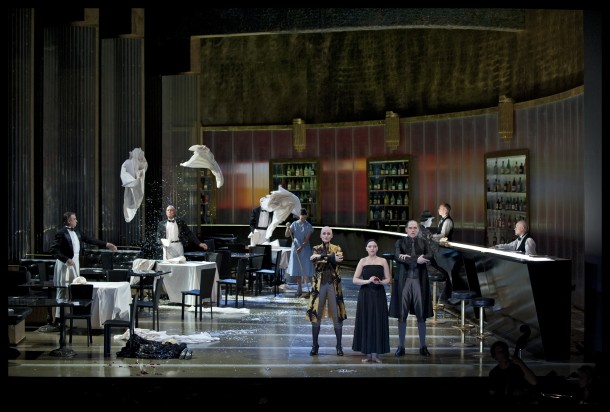
The Triumph of Time and Disillusion by Georg Friedrich Händel, directed by Jürgen Flimm. Photo credit:
At the forefront of the stage, Time and Disillusion struggled with Pleasure for the soul of Beauty. Behind them was a continually changing spectrum of persons in the bar. Different characters came and went. Three blind men led by little girls entered and were brought drinks by the girls, a bride sat alone until she arose and danced with two sailors, a man suddenly fell dead on the floor as Beauty and the others looked at him. In the end Beauty renounced Pleasure and kneeled at the front of the stage. As she sang she removed her jewelry, her make-up, and a blonde wig. With the assistance of Time and Disillusion she removed her elegant gown and the last moments saw her dressed as a nun, preparing to enter a cloister, her arms raised to heaven.
These five productions indicate something of the richness and range of theatre-going in Berlin, with large audiences filling the presentations of the three opera companies, the ballets, and the many theatres.
has long had an interest in theatre and opera in Germany. She was the American Consultant for The Iceman Cometh at the Deutsches Theater. She presented several lecture performances for Amerika Haus including “Eugene O’Neill Onstage,” “American Women Playwrights,” and “Tennessee Williams’ South” which she now performs in Europe and America. She has written twelve books and continues writing and presenting papers at conferences.
European Stages, vol. 6, no. 1 (Spring 2016)
Editorial Board:
Marvin Carlson, Senior Editor, Founder
Krystyna Illakowicz, Co-Editor
Dominika Laster, Co-Editor
Kalina Stefanova, Co-Editor
Editorial Staff:
Elyse Singer, Managing Editor
Clio Unger, Editorial Assistant
Advisory Board:
Joshua Abrams
Christopher Balme
Maria Delgado
Allen Kuharsky
Bryce Lease
Jennifer Parker-Starbuck
Magda Romańska
Laurence Senelick
Daniele Vianello
Phyllis Zatlin
Table of Contents:
- Hamlet in a Curious Nutshell by Maria Helena Serôdio
- Alvis Hermanis Productions in Latvia and German-Speaking Countries by Edīte Tisheizere
- The Unknown, the Unexpected, and the Uncanny: A New Lorca, Three New Catalan Productions, and a Few Extras by Maria M. Delgado
- 2015 Dance Week Festival and Contemporary Croatian Dance by Mirna Zagar
- Archives, Classics, and Auras: The 2016 Oslo International Festival by Andrew Friedman
- The Stakes for City Theatres: Linus Tunström’s Farewell to the Uppsala Stadsteater by Bryce Lease
- Life is Beautiful? or Optimistically About Bulgarian Theatre? by Kalina Stefanova
- The Multiple Dimensions of the Bulgarian ACT Independent Theatre Festival 2015 by Angelina Georieva
- Theatre in Berlin, Winter 2015 by Steve Earnest
- Musical Theatre in Berlin, Winter 2015 by Steve Earnest
- Gob Squad’s My Square Lady at the Komische Oper by Clio Unger
- New Productions in Berlin by Yvonne Shafer
- Manifest for Dialogue: Antisocial by Ion M. Tomuș
- A Fall in France by Heather Jeanne Denyer
- The Iliad as an Oratory: A Warning to a Civilization by Ivan Medenica
- Escaped Alone by Caryl Churchill at the Royal Court Theatre by Rosemary Malague
- Bakkhai at the Almeida Theatre reviewed by Neil Forsyth
Martin E. Segal Theatre Center:
Frank Hentschker, Executive Director
Marvin Carlson, Director of Publications
Rebecca Sheahan, Managing Director
©2016 by Martin E. Segal Theatre Center
The Graduate Center CUNY Graduate Center
365 Fifth Avenue
New York NY 10016



